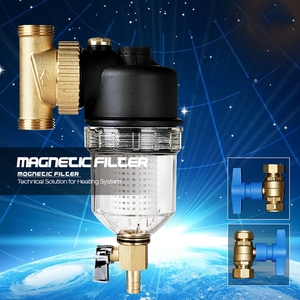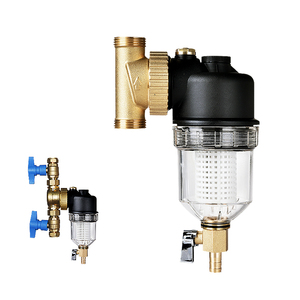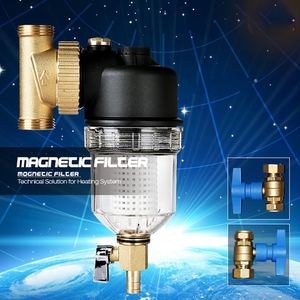
All categories
Featured selections
Trade Assurance
Buyer Central
Help Center
Get the app
Become a supplier

(61859 products available)


















































The power module filter is a passive component integrated into the power modules to suppress unwanted noise and ripple from the output voltage, providing a clean output voltage for the load.
LCRC power filters
The LCRC filter consists mainly of inductors, capacitors, and resistors. A typical configuration includes an inductor, capacitor, resistor, capacitor, and inductor again. The dual capacitor configuration allows for a better range since they can parallel together to cover a broader bandwidth of noise frequencies. The use of resistors also helps to eliminate ringing and peaking in the response. The inclusion of resistors also helps to improve damping and decrease Q-factors. Damping is important in power filters since it allows the transient responses to better suit the application.
LC power filters
The LC filter consists of inductors and capacitors. It works by blocking the unwanted EMI noise, which resides in a higher frequency range and allowing the signal and other components in the lower frequency range of the power module to pass through. The implementation can be done in a series or parallel configuration. Other configurations include the Buck module which has a pi filter configuration at the output. Inductors are the primary components in the power LC filter. They work by utilizing a magnetic field when current passes through them to block any high-frequency noise. In a simple power LC filter, capacitors are connected to ground and used as a path for high-frequency noise to exit the circuit.
RC power filters
RC filters use resistors and capacitors to filter out the undesired higher noise frequencies. The capacitor works as a path for unwanted high-frequency noise to exit the circuit. At the same time, resistors limit the current within the circuit. RC filters are present in many power modules as part of the final filter. However, they do not provide as massive attenuation of high-frequency noise as inductor-based filters.
The Power module filter specifications will vary depending on the type and application. However, here are some standard specifications that buyers should expect.
Some power module filters require special maintenance. Nevertheless, here are some general maintenance tips that will apply to most power filters.
Power module filters are used in various industries and applications to improve power quality by reducing voltage transients, switching noise, and electromagnetic interference.
Users can consider the following factors when choosing power module filters for specific applications.
Prioritize circuit characteristics
Understand the electrical specifications of the device to be used. Focus on features like component size, power handling capability, ripple current requirements, and voltage ratings. Aim for compatibility and seamless integration with the circuit.
Choose the right filter type
Select the appropriate power line filter according to the source and load characteristics. Consider the presence of high-frequency noise, its origin, and the type of filter suitable for addressing it. For common-mode noise, a common mode choke is recommended. For differential-mode noise, use an X-capacitor with a resistor in a filtering network.
Consider the filter's bandwidth
Focus on the frequency range that the power filter operates within. Ensure that the filter's bandwidth aligns with the application's requirements. A low-cut filter may be suitable for applications with high-frequency signals, while a band-pass filter may be necessary for specific signal transmission needs.
Input-output isolation
If isolation between input and output is essential, consider a filter with galvanic isolation. Such filters use isolation transformers to provide electrical separation. This is useful when avoiding ground loops or minimizing the influence of noise from one circuit to another.
Surge protection
For sensitive electronic equipment, consider using a surge protective device (SPD) within the power filter. This provides additional protection against voltage surges caused by lightning or switching operations, enhancing the system's overall resilience and reliability.
Size and mounting
Consider the physical dimensions of the power filter and its mounting options. Choose a filter module that fits the available space in the enclosure and has the required mounting style for the assembly process.
Cost
Finally, the cost of the power filter module is also an important factor in decision making. The selected filter should meet technical requirements and performance indicators while being within the specified budget range, providing cost-effective solutions for the project.
Q1: How does a powerline filter work?
A1: A powerline filter works by separating the noise-carrying lines. By using capacitance to couple high-frequency noise to the neutral line, it prevents the noise from getting into the load and using inductance to keep the noise from getting into the upstream line.
Q2: Do power filters work?
A2: Power filters do work. The power line conditioner can remove a full spectrum of electrically transmitted noise from the incoming power.
Q3: What is the difference between a power filter and a power conditioner?
A3: A power filter serves to remove specific unwanted frequencies from the mains electricity. On the other hand, a power conditioner will alter the characteristics of the power supply, usually by adding or removing particular frequencies.
Q4: How do powerline filters work?'
A4: Powerline filters work by using LC (inductance and capacitance) low-pass filters to block high-frequency noise from electrical devices in the mains electricity.